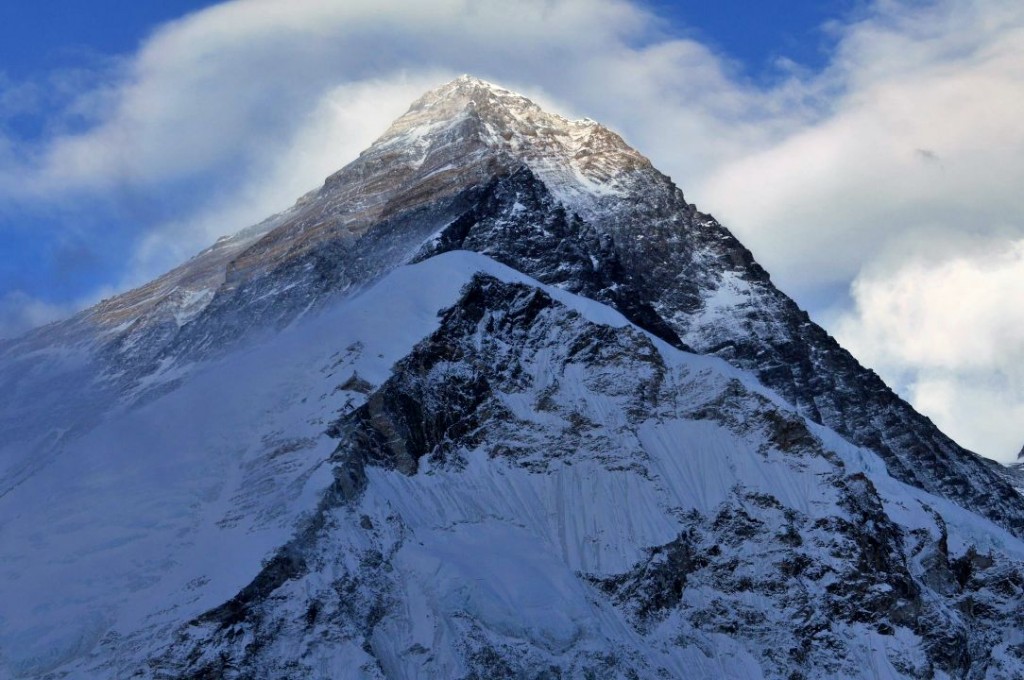
May 12, 6pm: Mt Everest in evening light from Camp 1 on Pumo Ri, which sits across the valley from Everest.

May 12, 6pm: Mt Everest in evening light from Camp 1 on Pumo Ri, which sits across the valley from Everest.
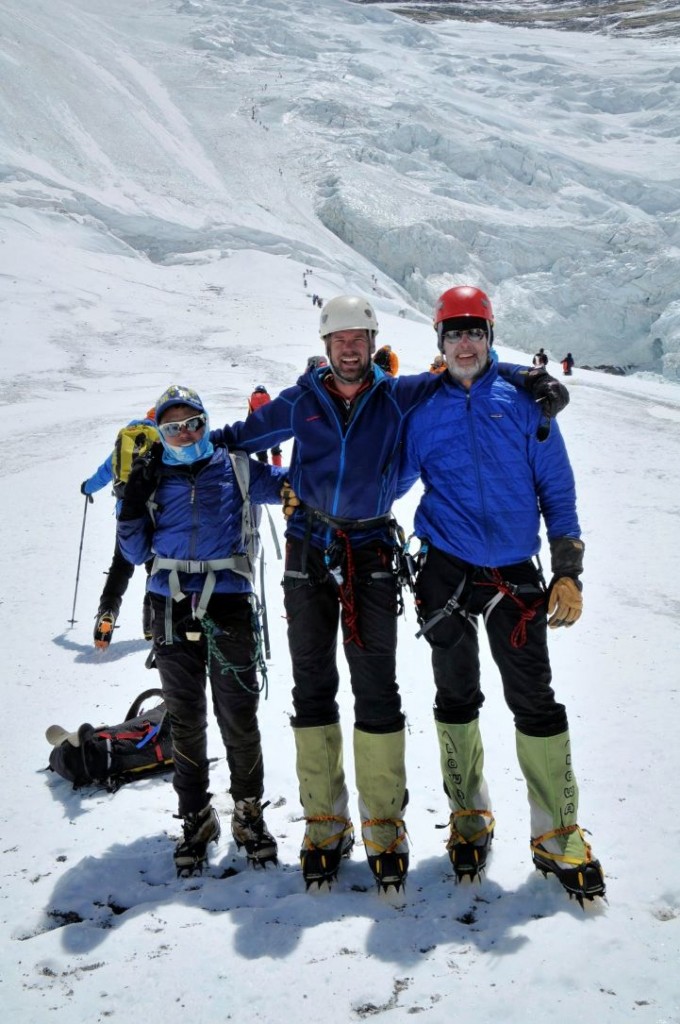
Kancha Nuru Sherpa, Kurt Wedberg, and Fred Simmons near the base of the Lhotse Face during an acclimatization day hike on May 1.
It is snowing in Base Camp today May 5 as we write this. After spending several days sleeping up high we are safely back to rest and recuperate. We started off on schedule on April 28 and moved straight up to Camp 2 at 6495m/21,309′. Our plan was to rest a day, then take a couple day hikes, followed by a move up to Camp 3 at 7406m/24,300′ to sleep.
We acclimatized well at C2 and after three nights we were ready to move up to C3. We nixed that plan when we got to the base of the Lhotse Face, which is the next portion of our route. It turns out the Everest region is very dry right now. It hasn’t received much snow from the past winter. Normally the face would be solid firm snow but instead it is hard ice. Additionally, rock faces above that are usually frozen and covered in snow are now exposed with loose rock. Rocks are coming down the slick icy Lhotse Face at high speeds. We didn’t think it safe to ascend it in these conditions so we didn’t. Concerns were shared among several guides who were at C2. A bunch of us got together for a meeting to discuss route conditions and options. We decided a few people who were still fresh would explore a different way up to C3. The good news is a route was found to the lower end of C3 and a small party anchored fixed line into that area. We spent one more night at C2 then returned to Base Camp.
Our four nights we spent in total at C2 were productive. We got noticeably stronger each day and stayed healthy the entire time living at 6495m/21,309′ and above. In spite of falling short of reaching C3 we feel that after our time up high followed by a few days rest at Base Camp we will be ready to make a summit attempt. Before trying for the summit though we also need a big change in the weather pattern. The upper reaches of Mt. Everest have been pummeled by 120+ mph winds for several weeks now. With conditions like this a summit bid isn’t realistic. We also need some fresh snowfall; preferably 1′-2′. This would offer some anchoring of the slopes containing loose rocks. Fortunately our forecast over the next dew days is calling for just that; decreased winds and snowfall through May 10. Let’s hope the weather forecast is correct!
Up until this point our expedition has gone according to plans almost as smooth as clockwork. This is the first time we have encountered any amount of resistance from the mountain. In mountaineering there are things you can control and others you can’t. Our strategy now is to take care of the things we can control and set ourselves up for success should Mt. Everest present an opportunity to climb it. We are back at Base Camp resting, hydrating, recuperating, getting strong after spending time up high, staying healthy, and are preparing ourselves physically and mentally for a summit attempt. In spite of the conditions we recently encountered we are optimistic we will have an opportunity make a summit attempt soon! Thanks to everybody for your continued prayers and support. Your comments on the blog are awesome too! We will try to update you as soon as conditions on the mountain shake out over the coming days and we have our next plans in place.
Here are a few pictures from the last few days:
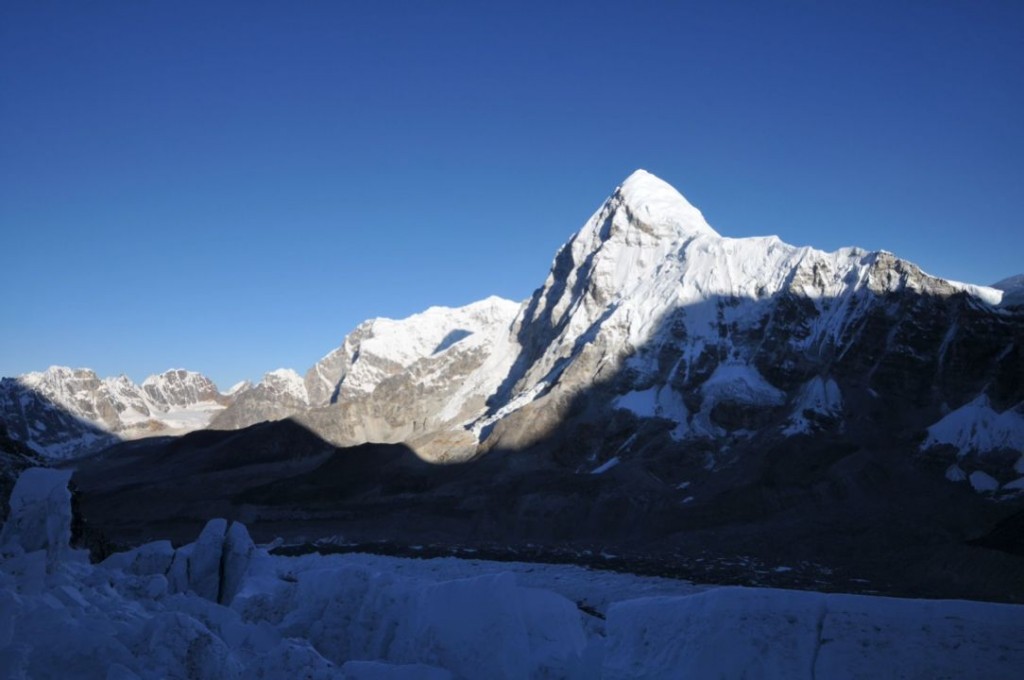
April 28, 6am: Looking back from the lower Khumbu Icefall at the early morning light on Pumo Ri (7165m/23,507') rising high above Everest Base Camp still in shade below.
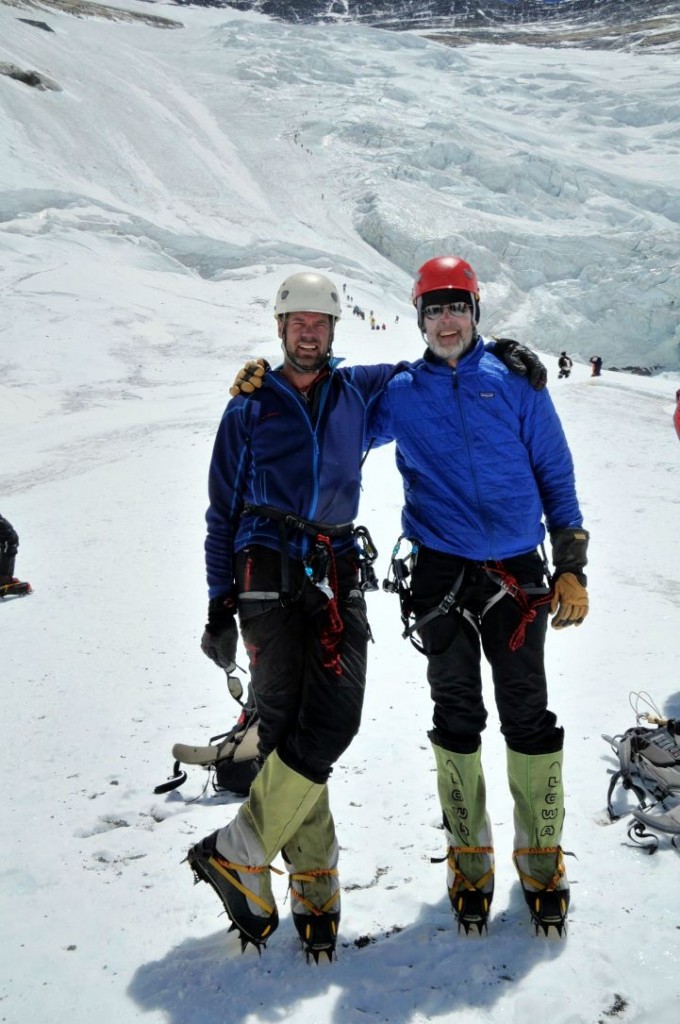
May 1: Kurt and Fred near the base of the Lhotse Face. The people in between their heads behind was as close as they were willing to get to the face without being exposed to rock fall from above.
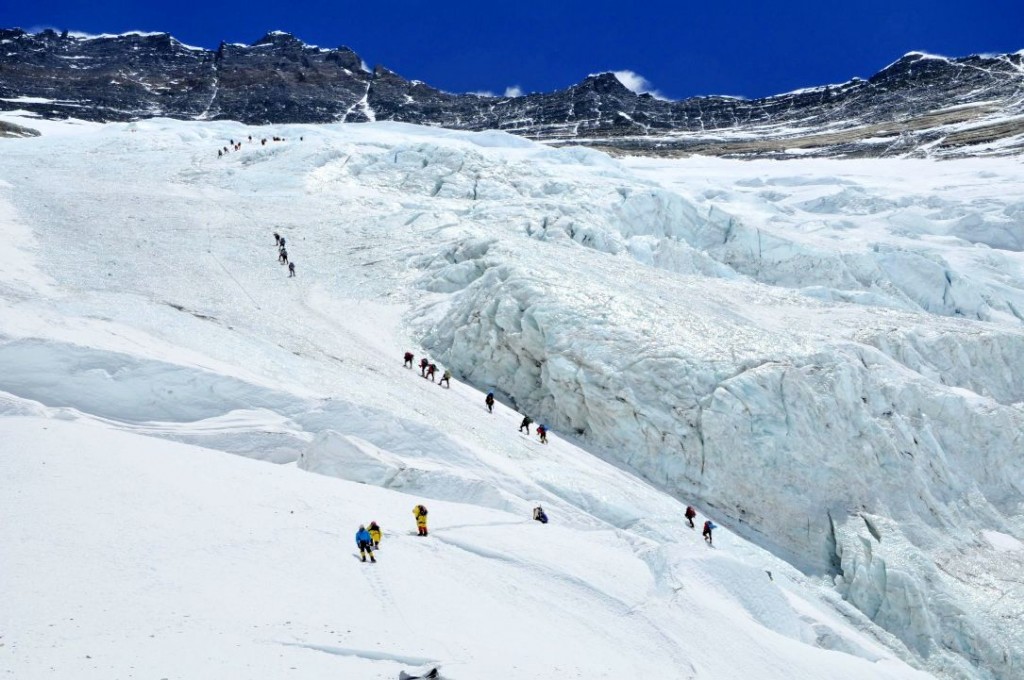
Climbers starting up the Lhotse Face in spite of constant rockfall. The source of the rockfall is from the Geneva Spur out of the photo to the left. Rocks small and large were raining down at a rate of 2+ per minute. These climbers were yelling "rock" while they slowly ascended completely exposed to the barrage.
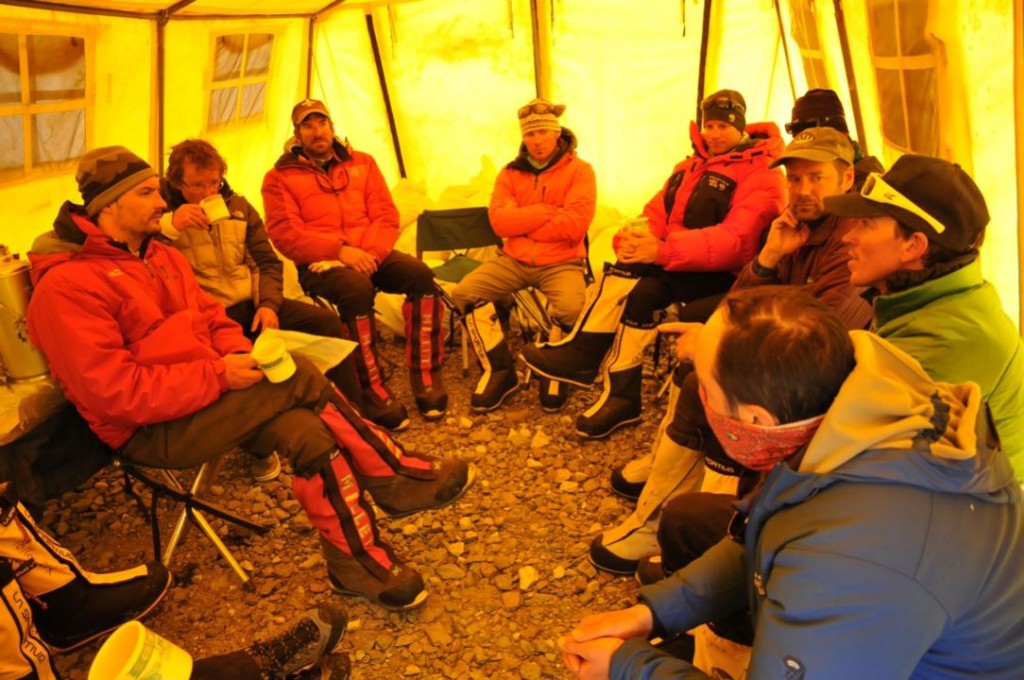
Mt Everest guides discussing route conditions and options on the Lhotse Face. We all agreed exposing our clients, Sherpa's, and guides to the current conditions is unacceptable. Seated far left Max, Damian Benegos, Dave Hahn. Far right Eric, Adrian, Kurt Wedberg. (note: some full and last names left out upon request).
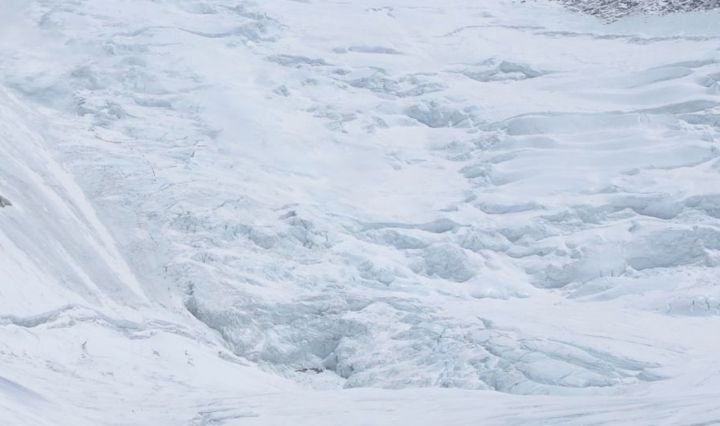
This cut away photo of the Lhotse Face attempts to show the old and new routes to Camp 3. The new route starts at the lower right of the photo and ends on the upper left. The location of the route exposed to rockfall starts on the lower left of the picture where the large horizontal crevasse ends on the right.
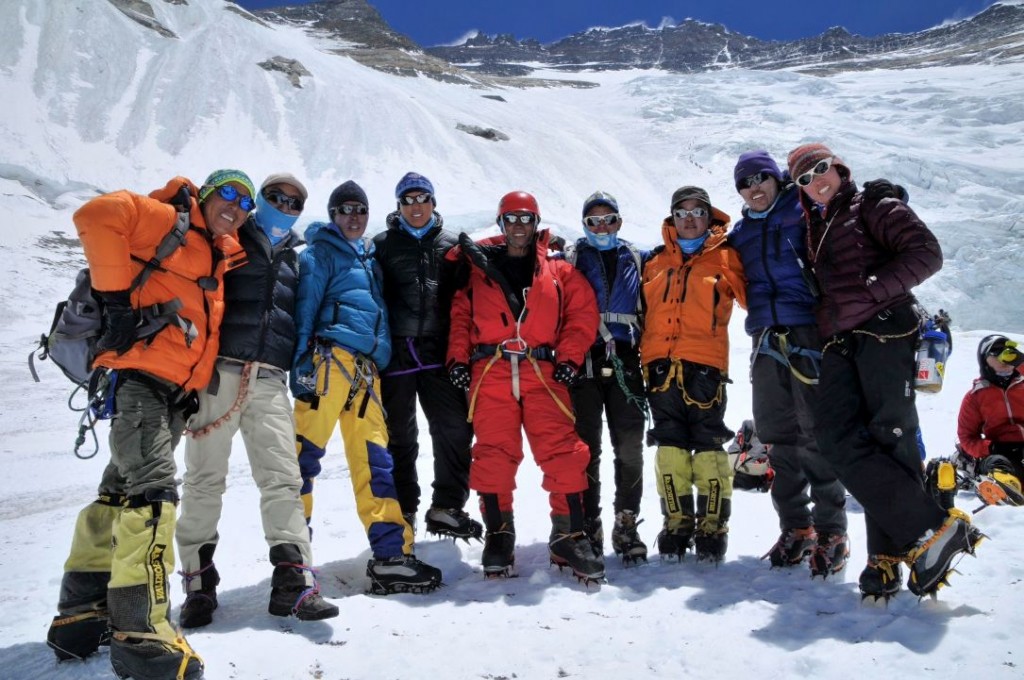
Some of our crack group of Sherpa's. There are no stronger people on the planet at extreme high altitude. Some of them will assist in carrying loads to our high camps and some will climb along side our team members on our summit attempts. From left to right: Pasang, Pemba, Cheten Dorjee, Phinjo Dorjee, Nima Nuru, Kancha Nuru (Phortse), Dasona, Phura Ongel, Kancha Nuru (Pangboche).
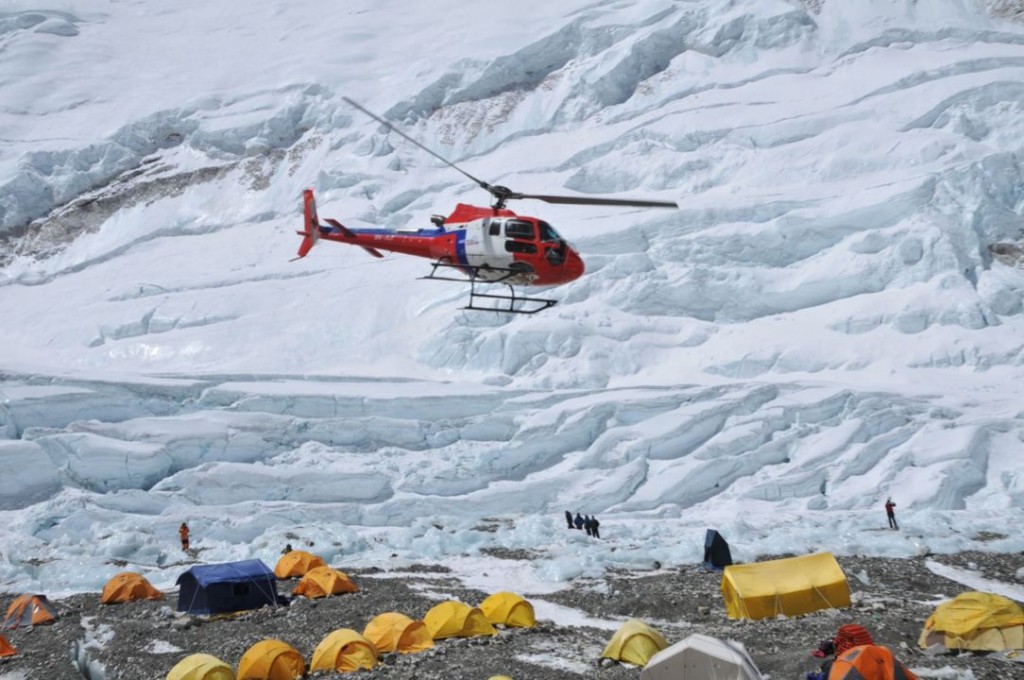
A helicopter hovering above Camp 2. Since the 1996 disaster on Everest it hasn't been until now that a helicopter can reliably reach this camp. The helicopter took two test flights with separate pilots taking turns at the controls. The following day they flew to 7600m/24,934'!!!
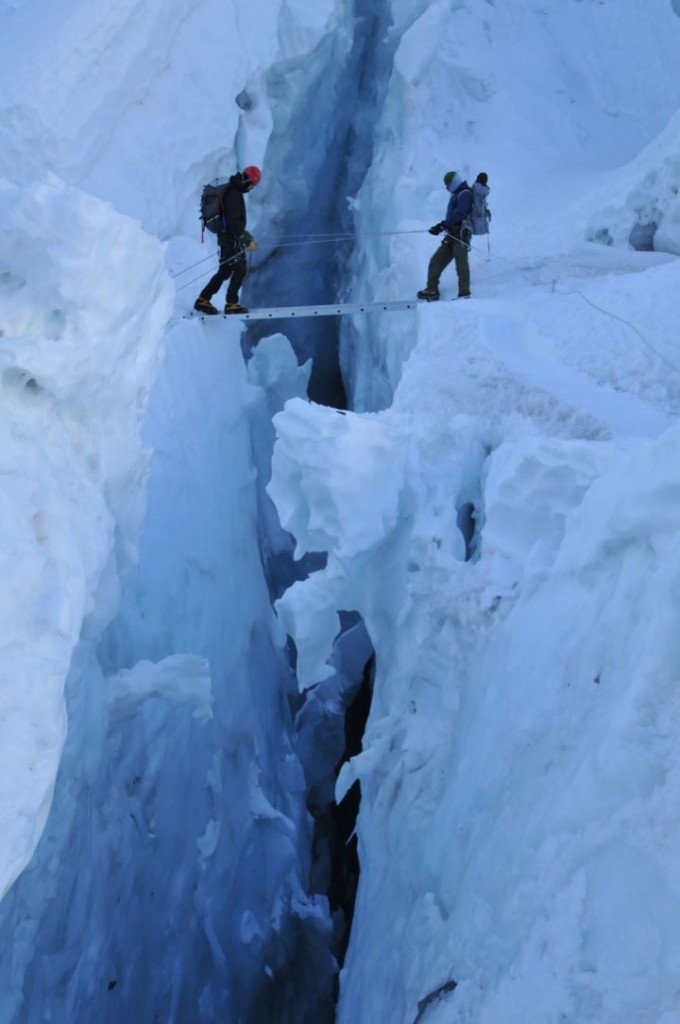
May 2, 7:30am: Fred crossing over a deep crevasse on a ladder in the Khumbu Icefall on our descent back to Base Camp.
Everest Base Camp Living!
Greetings from Everest Base Camp. Since last we checked in we had just descended from C2 after sleeping a few nights up high. Since then we have spent the last few days resting, hydrating, consuming lots of calories, and in general regenerating our bodies and planning for our next trip up high.
.
The days spent at Everest Base Camp are an excellent excuse to relax and be lazy. One of the joys of expedition climbing is having time to sit and enjoy a good book, write, and take some time to simply relax “guilt free” which has become an increasingly rare commodity in our modern society. We also find a renewed appreciation for the simple things in life such as an unhurried hot shower or putting on a clean pair of socks and a fresh t-shirt for the first time in several days.
.
Weather has been pretty typical for April in the Himalayas. Night time temperatures dip into the teens or low 20s. During the daytime the mornings are clear, sunny, and usually very pleasant with little to no wind. Most afternoons see the skies turn partly cloudy. Occasionally it will cloud over enough for light snow to fall. The ridge lines above 7000m or 24,000′ have been getting hit by strong winds of 60+ mph, which is typical for this time of year. Recently at Base Camp we have seen the first signs of the coming spring. Temperatures are starting to gradually warm up and the sun is peaking over the ridge tops a little earlier each morning.
.
After several days of rest and preparation we are now ready to make our next trip above Base Camp. These forays we make to higher camps are referred to as “rotations”. Here is the plan for our next rotation:
.
April 28: Climb to C2 (6495m/21,309′)
April 29: Rest at C2, small hike to stretch our legs
April 30: Hike to the base of the Lhotse Face, return to C2
May 1: Climb the Lhotse Face to C3 (7406m/24,300′), sleep here
May 2: Return to C2
May 3: Return to Base Camp
.
A special thanks to everybody for following along with us through this blog. For all of you who have written words of encouragement in response to our posts on this blog please know we have read every single one of your comments. Thank you for your continued prayers and support. We will plan on checking in again after returning from our next rotation up high.
.
Below are a few pictures from the last few days of Base Camp living:
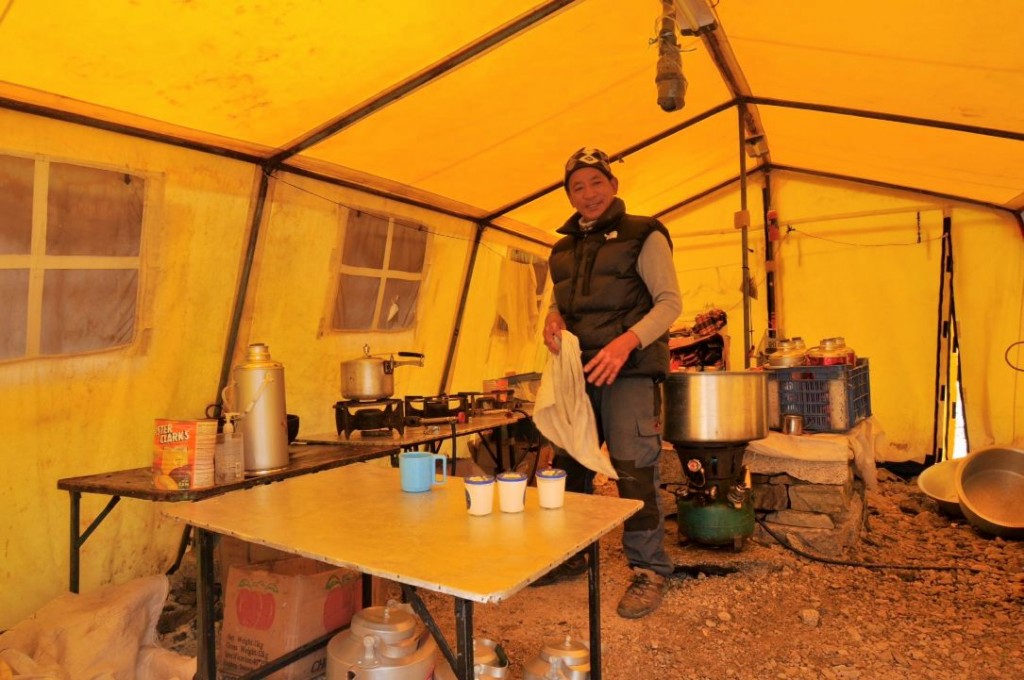
One of our awesome Sherpa cooks in the kitchen. Our kitchen equipment includes several large propane burners hauled in by yaks. All water is boiled and the cooking area is kept clean at all times. These guys do a fantastic job in a challenging environment keeping us fed three square meals a day!
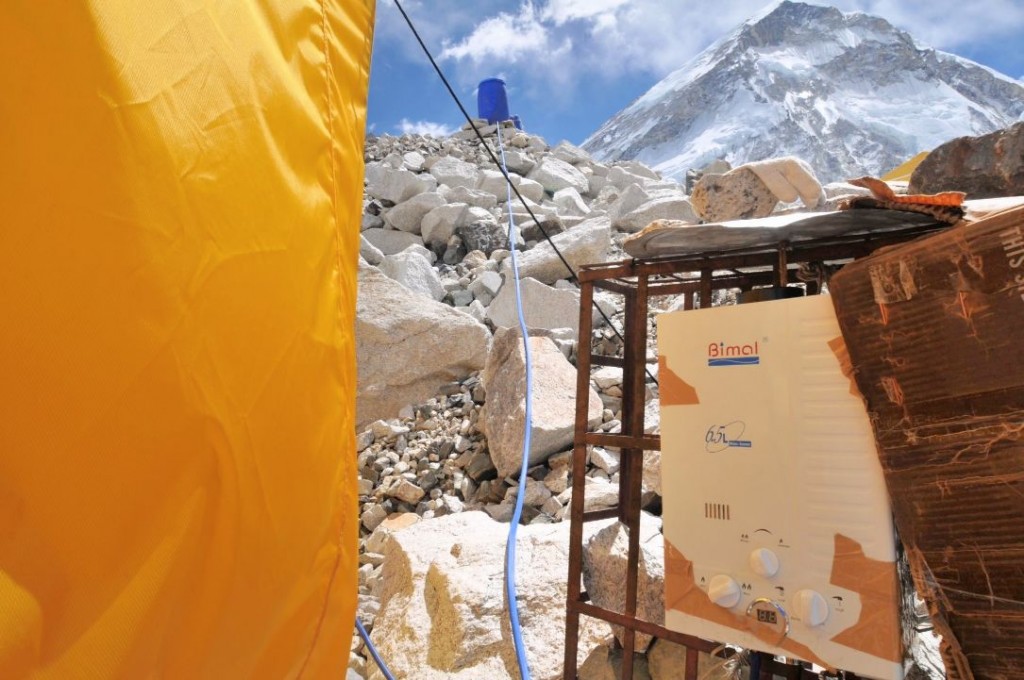
Our Base Camp shower's plumbing. A large blue drum is filled with icy water from the Khumbu Glacier. The water travels down a syphoned hose and passes through a gas powered "on demand" water heater on its way to the shower head.
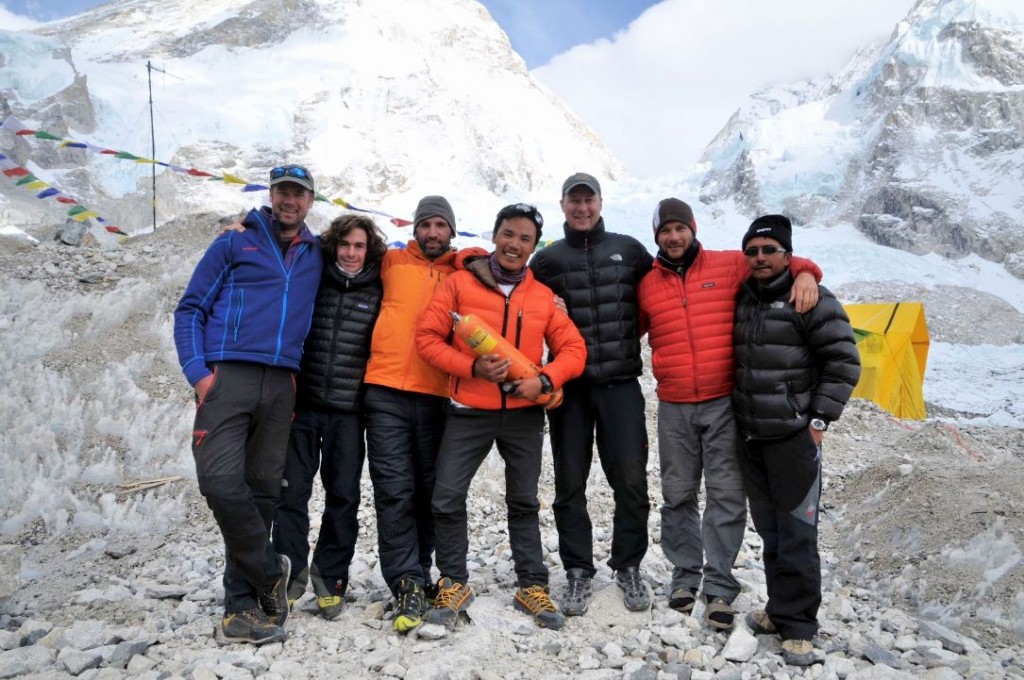
Rest days are a great time to visit friends we are sharing the mountain with. On one afternoon Kurt and Atte visited long time good friends from Argentina. Over several rounds of South American Yerba Mate we caught up with Fernando Grajales and friends who help us with expedition logistics when we guide our Aconcagua expeditions. Left to right: Kurt, Fernando, Tomas, a Sherpa, Atte, Luciano, and another Sherpa.

April 19: Fred crossing a ladder spanning a large crevasse in the upper Khumbu Icefall en route to Camp 1.
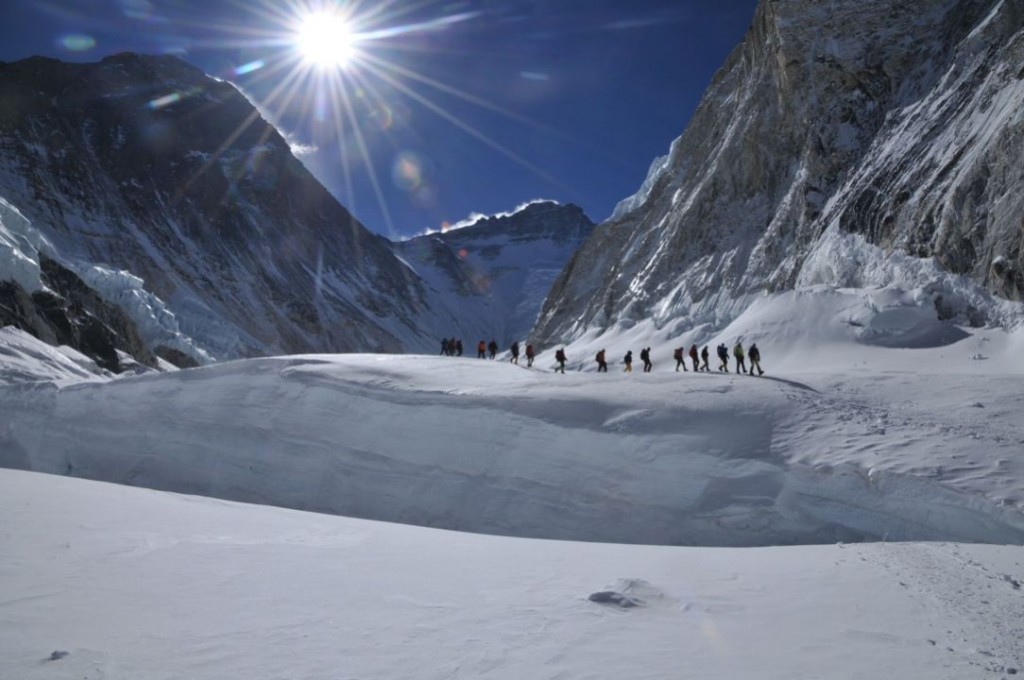
April 20: Looking up the Western Cwm during a day hike. Lhotse is the right peak on the skyline. The summit of Everest is just starting to reveal itself as the highest point on the left skyline.
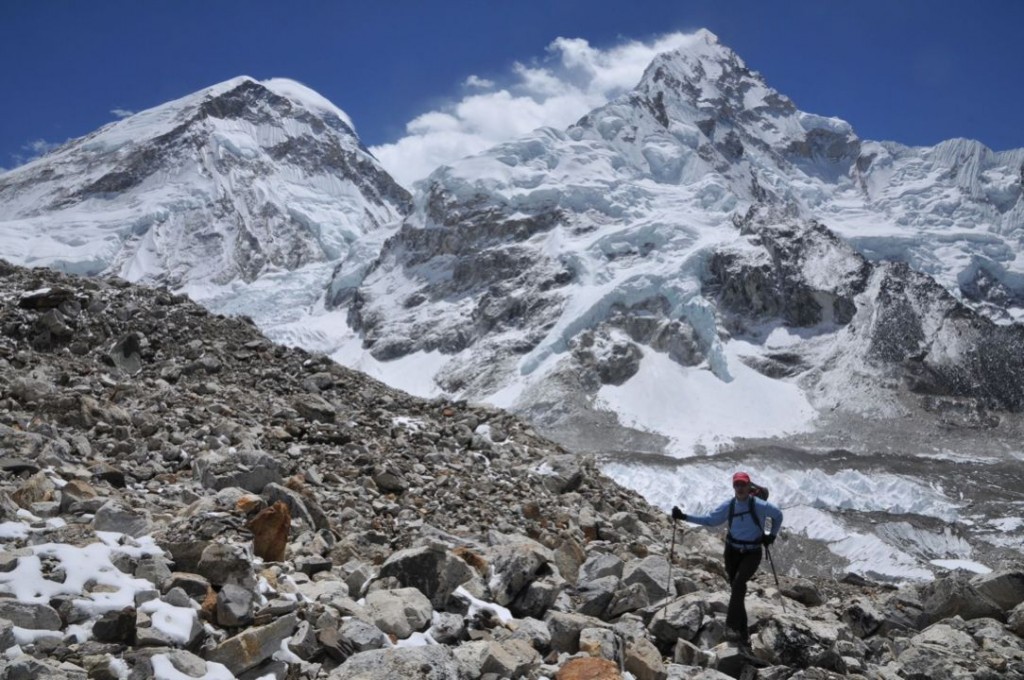
Fred enjoying an acclimatization hike on Pumo Ri above Base Camp with the dramatic backdrop of Nuptse (right) and Everest (left).

Mt. Everest (8850m/29,035') and Lhotse (8516m/27,939') the first and fourth highest mountains in the world with the Tenzing Norgay monument in the foreground. The first ascent of Mt. Everest is credited to Sir Edmund Hillary and Tenzing Norgay Sherpa. This monument was built in 2003 in honor of Tenzing Norgay.
After 3 nights in Namche Bazaar we hiked 5 hours to the village of Deboche at 3820m/12,533′ where we spent the nights April 1 and 2 at the Rivendell Lodge.
Deboche is located 40m/131′ below Tengboche, site of the most well known Buddhist monasteries in the Khumbu. The team visited the monastery then went next door to the best bakery in the Khumbu. We sat outside enjoying freshly baked apple pie and chocolate cake under sunny skies with views of Everest (8850m/29,035′), Lhotse (8516m/27,939′), and Ama Dablam (6856m/22,493′).

The entrance to the Tengboche monastery.

Kurt and Fred at the Tengboche monastery.

Inside the Tengboche monastery.
On April 3 the team packed up to move to Pheriche (4240m/13,910′). Along the hike we were treated to a close sighting of a group of Nepalese mountain goats perched on a shelf directly above our trail. Moving higher the team passed through Pangboche where we visited Lama Geshe, a local monk who offered his blessing on our climb. His blessings included chanting, incense burning, and the presentation of a scarf an a choker around each trekker’s neck along with a delicate “head butt”. After our visit the weather turned cloudy and by noon light snow was falling. We stopped at a tea house for lunch then finished our hike to Pheriche with snow creating a thin blanket on our trail.

A Nepalese mountain goat watching us from a perch above our trekking route.

Fred and Kurt on a suspension bridge spanning a river filled gorge far below.

Fred getting a "head butt" blessing from a lama in Pangboche.
The weather cleared on April 4 and the team decided to take an acclimatization day hike above Pheriche where we got nice views of the surrounding peaks. Besides Everest there are many spectacular peaks in this region of the Himalayas. Every new bend in our route reveals more of these beautiful mountains. We feel humbled and truly blessed to be among these great peaks, many of which rise over a mile above us and are relatively unknown among the general mountaineering community. Peaks within our field of view today included Tabuche (6495m/21,308′), Cholatse (6335m/20,784′), and Arakam Tse (6423m/21,072′) as well as the more well known Island Peak (6189m/20,304′), which is one of the most popular trekking peaks in the region.
Located in Pheriche is a high altitude medical clinic that has been in operation since 1973. The Himalayan Rescue Association staffs it with doctors who provide service to trekkers and climbers in need of medical attention. The work done here over the past 39 years has led to a large contribution of what we know about high altitude medicine today. The team visited the clinic in the afternoon after our day hike where one of the doctors shared some insights on high altitude medicine then gave us a tour of the facility.
On April 5 our plan is to move to Lobuche (5290m/17,355′) Base Camp. Lobuche is another trekking peak in the area. It’s Base Camp will be a nice place to continue our acclimatization. We’ll spend three nights here then trek to Everest Base Camp! It looks like we’ll be “out of range” from the outside world during this time. The next time we expect to check in will be after we’re settled at Everest Base Camp.
We want to thank everybody for all your prayers and support during our journey so far. We look forward to being in touch again soon!!

A Sherpani girl in Pangboche.

Sherpa's in Pangboche cultivating their fields preparing for the upcoming growing season when the monsoons come in June.

Yaks being herded past our route as the snow began to fall en route to Pheriche. Yaks are the local beast of burden in Nepal and Tibet. They normally live above 10,000'.

Fred nearing Pheriche Pass (4218m/13,838') en route to the village of Pheriche in a white out while light snow continued to fall.

Fred (right) and fellow team member Bandar (left) crossing a bridge shortly before arriving at Pheriche.

Fred and Kurt arriving at the Himalayan Hotel in Pheriche, the tea house where they slept in for two nights.

Fred, Brad, Lisa, Vanessa, and Karl enjoying the spectacular views on a day hike above Pheriche.

Kurt and Fred pause on a ridgeline where rocks were stacked to hang prayer flags during an acclimatization day hike above Pheriche.

A Himalayan Griffon souring above checking us out during our acclimatization day hike above Pheriche.

SMI founder and guide Kurt Wedberg with Ama Dablam in the background. Kurt climbed this mountain by the Southeast Ridge in October of 1998.

A group picture at approximately 15,000' during an acclimatization day hike above Pheriche. Fred and Kurt are trekking and sharing Base Camp with them during their Everest expedition. Front row: Kurt, Lopsong Sherpa, Bandar, Brad. Back Row: Kevin, Jan, Andy, Karl, Dwayne, Lisa, Catherine, Mark, Ray, John, Jenni, Justin, Vanessa, Fred, Purna, Mingma, Atte, Furi, and Tashi.

Kurt Wedberg and Fred Simmons on the deck of the Everest View Hotel above Namche Bazaar. The peak to the right is Ama Dablam. Everest is obscured by clouds behind.

Kurt and Fred at the school at Khumjung (3780m/12,401'). After Sir Edmund Hillary became the first person to reach the summit of Mt. Everest he spent much of his life work to helping the Sherpa community. He helped found many schools including this one in 1961. The statue behind is a monument commemorating Hillary.

The village of Namche Bazaar sits in an amphitheater in the mountains of Nepal at 3440m/11,286'.

A Nepali lady at market day in Namche Bazaar.

Yak bells for sale in Namche Bazaar.

Sherpani's conducting business at market day i Namche Bazaar.

Men buying and selling fruit at market day in Namche Bazaar.

A local porter (left) buying fruit at the market in Nmche Bazaar.

The local meat market in Namche Bazaar.

A Nepali man selling hot peppers at the market in Namche Bazaar.

Kids in Khumjung.

Fred and Kurt greeted upon arrival in Kathmandu, Nepal.
Kurt Wedberg and good friend of SMI Fred Simmons have embarked on their much anticipated expedition to Mt. Everest! After all the planning and preparation they had one last meal with Fred’s family in Los Angeles then boarded a Thai Airlines flight bound for Kathmandu, Nepal on March 24. We will attempt to share highlights of the journey through this blog. This is the first entry as written by Kurt Wedberg:

Our last meal with Fred's family before flying to Kathmandu.

Fred boarding our Thai Airlines flight to Kathmandu, Nepal.
Greetings from the town of Phakding at 2620m/8596′ in the Khumbu region of Nepal. All the altitudes are in meters here. To convert we multiply by 3.2808.
After 24+ hours of travel from LA to Kathmandu landing on March 26 we spent two nights and one day in Nepal’s capitol city making final preparations before starting our trek into Everest Base Camp. We organized our equipment into gear that will be shipped by yak directly to Base Camp and other necessities that will be used during our 11-day trek. Fred and I have tacked ourselved onto a large tea run by my good friend Eric who has been organizing Everest expeditions for many years. We will be using all their logistics and support and be able to climb on our own schedule.
On March 28 we left our hotel at 4:45am and soon were at the airport where local flights originate from (versus where the international flights go in and out of). A bit of organized chaos ensued as we got 23 people plus 23 duffle bags through security. Shortly after 6am we were called to our flight and boarded a Twin Otter that holds about 15 people. We divided into two groups on separate planes and took off on the 45 minute flight that ended at the village of Lukla at 2840m/9300′ in the Solu Khumbu region of Nepal. This airport is a trip. The runway is angled at 11 degrees. This helps the airplane stop on this short runway. Upon exiting the plane there are several Nepali police officers who love blowing their whistles incessantly as we walk off the tarmac.
The first order of business was to get 23 porters matched with our 23 duffle bags. While that was going on we took some time to have a little breakfast. There are little bakery’s in Luka that have espresso and cinnamon rolls. This mountaineering business is tough work!! At 7:45am we took off on our trek. Today was a very easy trek. We had very little uphill mixed in with mostly downhill hence how we ended up 220 meters lower than where we started. We took a leisurely pace and got to Phakding 3 hours after leaving Lukla.
We’re staying in tea houses. These are little lodges that exist all up and down the Khumbu region. They have simple bedrooms and a dining room. The menus are pretty similar at all of them. There are American dishes like spaghetti, lasagna, pizza, and chips (french fries to you and me). They also have traditional Nepali food including dahl baht (rice with lentils) and momo’s, which are steamed dumplings with vegetables or meat.
For the next day of our trek we plan to hike approximately 6 hours to Namche Bazar at 3440m/11,286′. We plan to spend 3 nights here acclimatizing before trekking farther up the valley towards Everest Base Camp.
We will try to share a few photos from our journey on this blog. This may not always be possible though so we will also have them posted on the SMI Photo Gallery site here: http://www.kurtwedbergphotography.com/International-Expeditions/Everest-2012/22141785_sRN2QC

Upon arrival in Lukla we had espresso and fresh baked goodies at a local bakery before starting our trek.

Kurt at a Buddhist monument along the trekking route.

A young Sherpa watches from a distance as we trek by his home.

Fred crossing a suspension bridge over the Dudh Koshi River.